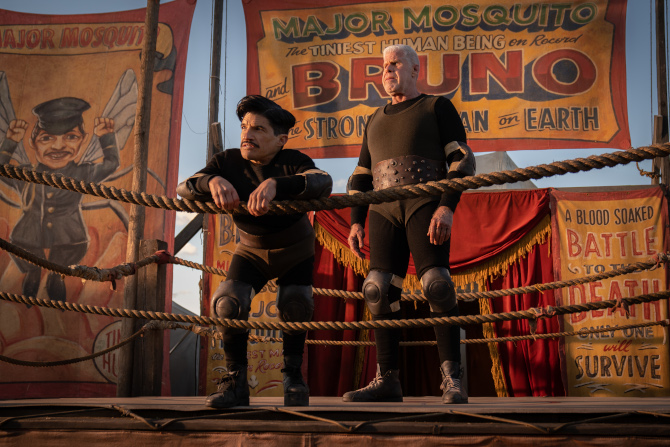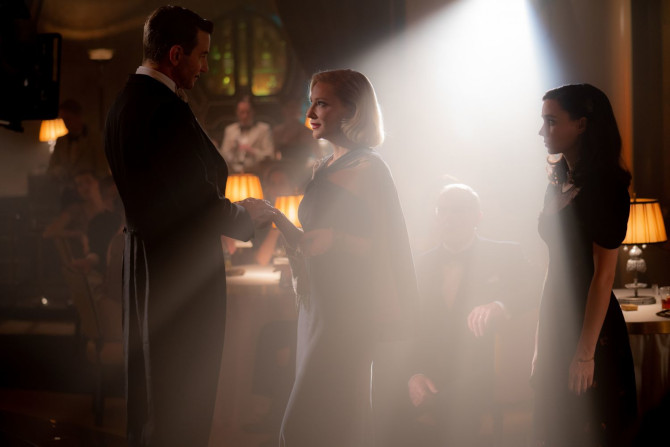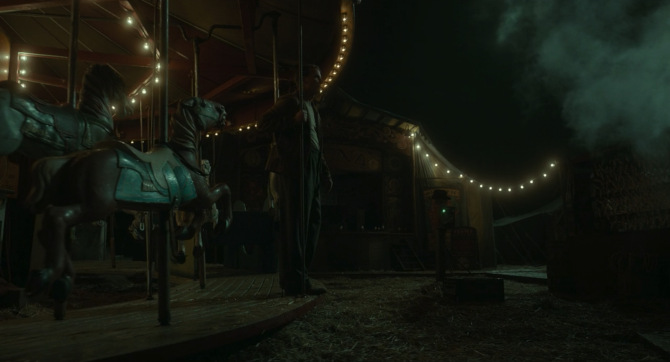Guillermo del Toro’s first foray into the realm of film noir, 2021’s Nightmare Alley brings all of the Golden Age classic charm of the Studio System along with a classic pulpy story (based off of the novel of the same name by William Lindsay Gresham. . . as well as the 1947 movie adaptation), which is then fused with his own unique visual style.
Following Stanton Carlisle (Bradley Cooper), a drifter, or is it grifter (after all, this is a neo-noir), with a dark past, he aimlessly stumbles upon a traveling carnival. . . taking a day’s work, he soon after accepts an offer from owner Clem Hoatley (Willem Dafoe) to join the team – seeing it as the perfect way to disappear from his secret history.
There is no denying that he is a hard worker, and he slowly ingratiates himself with the familial group, including Zeena the Seer (Toni Collette) and her drunkard husband and aid Pete (David Strathairn), strongman Bruno (Ron Perlman), and the shy wielder of electricity, Molly Cahill (Rooney Mara).
Seeing opportunity in nurturing the abilities of Zeena and Pete – he used to do something similar to her, that is the ability to read people and use coded language/secret signs to trick audiences into believing they have the power of soothsaying, the pair’s one rule is to avoid speaking to the dead. It is a dangerous path to tread, and if you journey too far down that dark alley, you might soon start believing in your own abilities – to the detriment of yourself and others.

Filmizon.com’s Nikolai Adams with Ron Perlman, who plays Bruno the Strongman in Nightmare Alley – his seventh role with del Toro (the most of any actor)
Eventually convincing Molly to leave with him, much to the chagrin of the overly protective Bruno (who was a friend of her father’s), the new couple move from what might rather rudely have been deemed a small town freak show, to the big city lights and wealthy elite world of Buffalo. Juxtaposed in short order, on the surface, there is no denying that the art deco infrastructure and high class attire is seductive in its beauty when compared to the mucky ground and oddball curios of an aged traveling carnival, yet that might not tell the whole story.
Soon, Stanton is meeting up with psychologist Dr. Lilith Ritter (Cate Blanchett), a cold, calculated femme who tried to hijack one of his newly polished psychic shows with Molly in order to see if he is a fraud. Seduced by her boldness, he enters her stunning yet austere office (Rorschach inkblots seemingly decorating the walls), looking to proposition her for information from her clients in order to ‘communicate’ with their dead relatives and keep the ruse going. After they have success with Judge Kimball (Peter MacNeill) and his wife (Mary Steenburgen), they move onto an ultra wealthy but equally as paranoid mark in Ezra Grindle (Richard Jenkins). . . but might this be going too far?
A multi-layered script (co-written by del Toro and Kim Morgan), the main storyline follows a rather typical noir-inspired path that is not likely to surprise those who have delved into the cynical World War II and beyond genre, yet it is what lays just beneath that truly elevates the piece. What at first looks like an upgrade, the move to Buffalo is not exactly what it seems. For all of its grandness and material beauty, there is a false reality that lays just beneath. The city does not hold the purpose and family camaraderie that the carnival once did. . . a place where one looked out for the other and worked together for the betterment of all. In the city, people look out for themselves and greed predominates. The old hokey tricks and simple but impressive gimmicks no longer work in the cynical city, forcing Stanton to push Molly into less safe scenarios and ones that don’t connect to her moral compass that still rests in her original home of the carnival. Their relationship quickly fractures, she yearns for her simpler past while he strives for a greedier future. The two women very much can be seen as the essence of this piece – Molly a kind, nurturing and motherly soul looking for the simpler things in life, whereas Dr. Ritter is a cold, conniving calculator of situations, seductive in a wholly different way. It should also be noticed that the form of the circle can be found throughout the visuals, a reminder that we all have the ability to evolve and change (in essence, stepping outside of said circle imprisonment), but that it is rather difficult to escape the traps we set for ourselves. . . leading to the repetition of past mistakes and often finding us right back where we started. This is the genius of this film’s ending. . . and that is all I will say.
It is also worth noting that despite this not being what one might consider del Toro’s wheelhouse of horror, he never truly leaves that genre. The curios and carnival activities certainly hold their roots within his beloved gothic tinged elements, while one death will remind viewers of something similar found in his Pan’s Labyrinth. Likewise, the climactic sting starts with what could be called an ethereal haunting that dissipates rather abruptly into something even more horrific.
A beautifully crafted motion picture, Nightmare Alley should appease both fans of film noir and modern cinema enthusiasts. One of the predominate cinematic crafters of our time, del Toro takes every opportunity to wow and amaze. Building the entire carnival, it oozes history – neon seeping into the fore and background, many of the items eerily real, it truly takes us to a time long since past. Lastly, for eagle-eyed viewers, the psychic foretelling of the story interacts with del Toro’s own hidden in plain sight foreshadowing – he himself performing the same acts as his characters in the movie. So, geek it up with this movie that mirrors past, present, and future – you might just be born for it.




